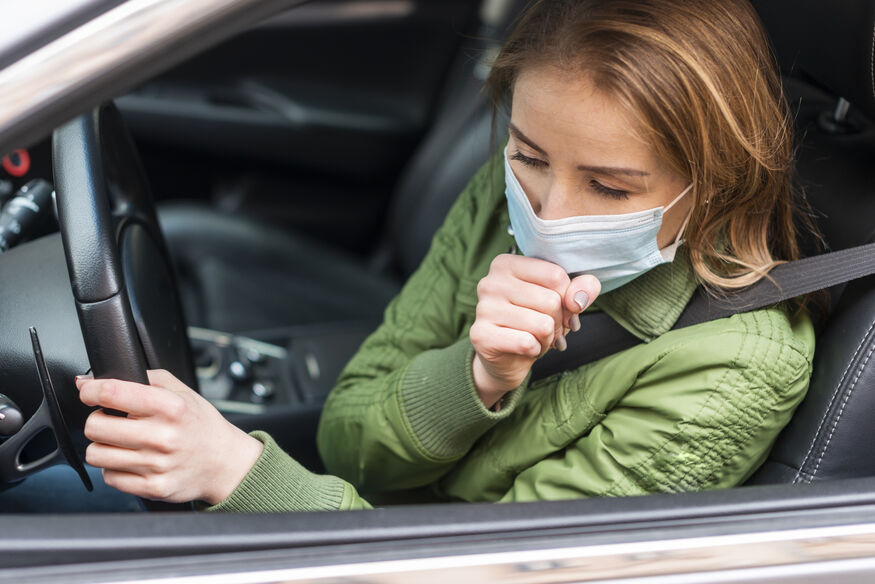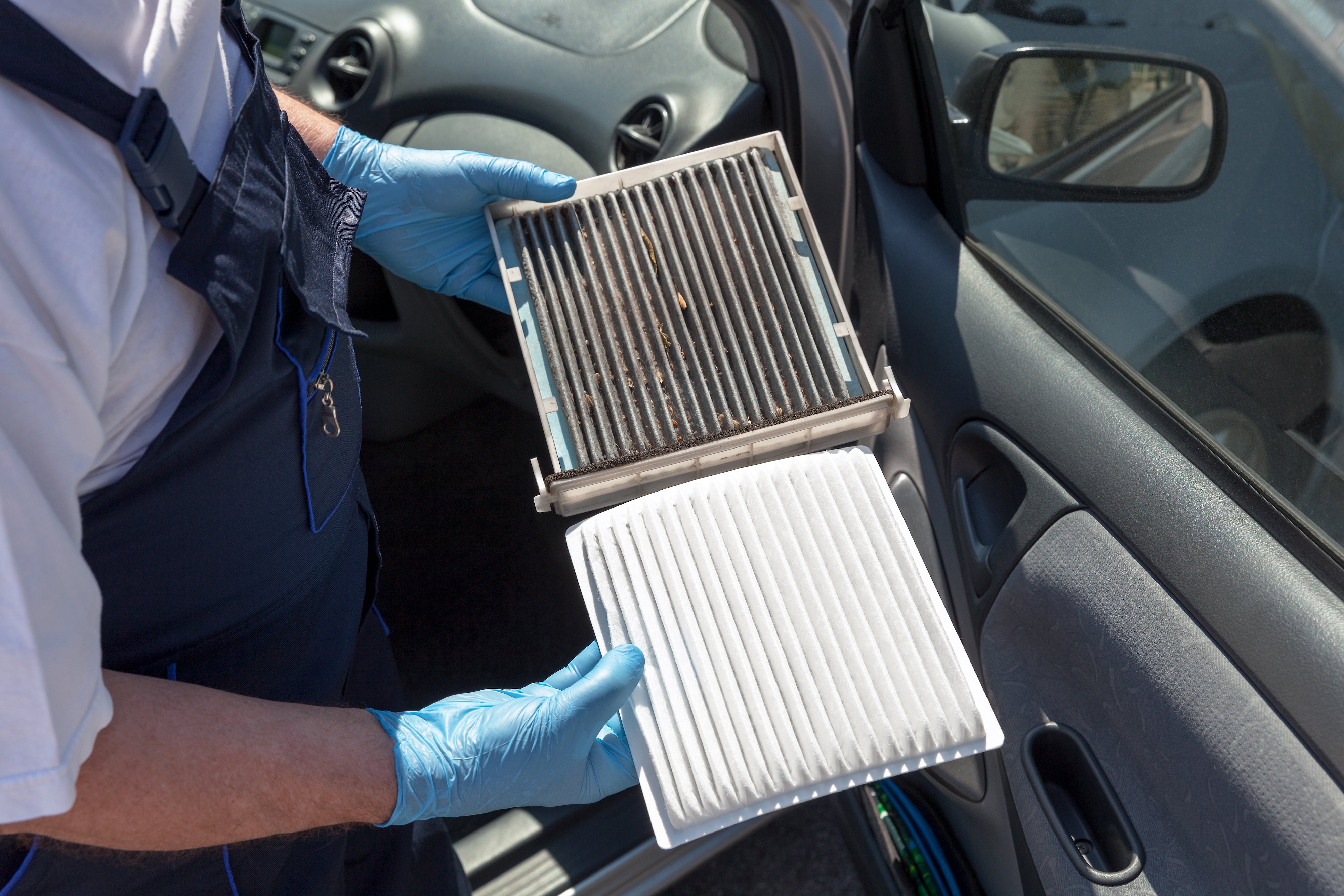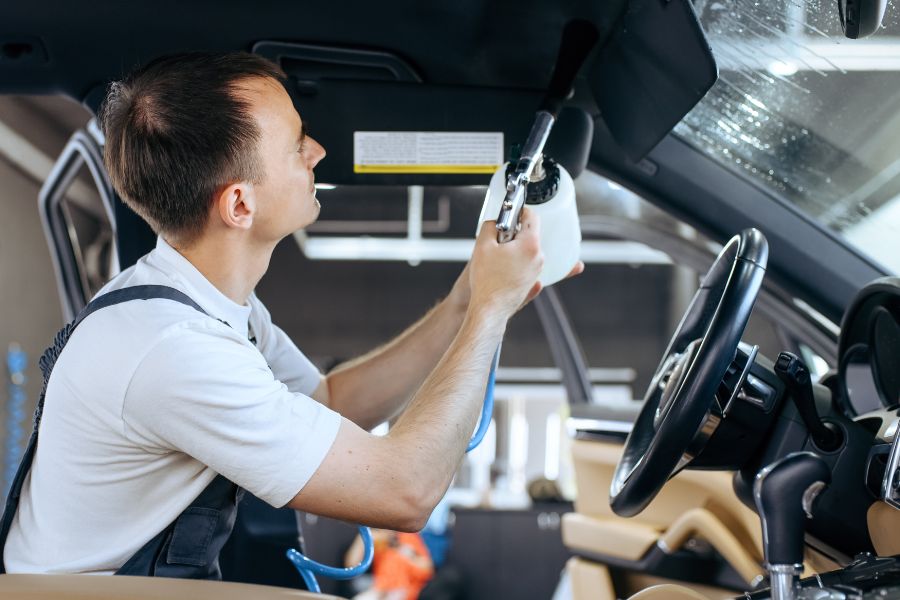Wondering how to get smoke smell out of your car? You’ve just scored a great deal on a used car and you’re pumped to hit the road—until you open the door and get smacked in the face by a cloud of old cigarette smoke. Gross, right? You’re not alone—over 30% of used car buyers run into this issue, according to a CarGurus survey. But this isn’t just about making your ride smell nice. That lingering smoke can affect your health, too. The CDC says smoke residue in cars can be 10 times more harmful than in a smoker’s home because of the enclosed space. Yikes! A fresh-smelling car not only makes your drives more enjoyable—it can also boost your resale value. I’ll walk you through exactly how to get smoke smell out of your car, step-by-step, whether you’re tackling it yourself or calling in the pros.
How to Get Smoke Smell Out of Your Car?
Ever wonder why smoke smells cling like a bad habit? It’s all about those sneaky little smoke particles—they’re super tiny and love to dig into porous stuff like your car’s upholstery, carpets, and headliners. Cigarette smoke and tobacco odors are a common problem in vehicles, especially those owned by smokers or exposed to cigarettes regularly. The cigarette odor can be overpowering and difficult to remove from car interiors. And here’s the real trouble: tar and nicotine in cigarette smoke act like glue, sticking to everything and laughing at your basic cleaning attempts. Tobacco residue and cigarette smoke contribute to the persistent cigarette smoke smell that lingers long after the last cigarette. It’s like trying to scrub peanut butter off a shag rug—good luck! A study from the University of California, San Francisco backs this up—they found cigarette smoke particles and cigarette odor sink deep into car fabrics, way beyond where a quick wipe can reach, making it especially challenging to remove from porous car materials. So, to really zap that smell, you’ve got to hit two targets: the surfaces and the air inside your car. It’s like a double whammy to send that stench packing!
Common Mistakes to Avoid
Okay, let’s talk about what not to do—because messing this up is way too easy. First off, don’t just grab an air freshener and pretend it’s fixed. That’s like slapping a sticker over a crack in your wall—it might smell nice for a day, but the stink’s still there. Many products simply mask cigarette odor instead of actually eliminating it, so a thorough cleaning is necessary if you want real results. A AAA survey says 40% of car owners try this lazy trick, and guess what? It doesn’t work.
Second, don’t skip the sneaky spots—smoke particles hide out in air vents, under seats, and in the HVAC system like little odor ninjas. Third, steer clear of harsh chemicals that might wreck your upholstery or plastics. Why swap a smell problem for a ruined interior? And here’s a big one: don’t forget the cabin air filter—it’s a secret stink trap tons of people miss.
Here’s my take—masking the smell is a cheap shortcut. If you want it gone for good, put in the effort. Trust me, your nose will thank you!
DIY Methods
You don’t need to be a car wizard to fight smoke smells—these DIY tricks are simple, wallet-friendly, and totally doable. I’ve laid out each one with materials, steps, and the pros and cons, so you’re not guessing what works. The cleaning process involves a series of steps including surface cleaning, deodorizing, and air filtration to effectively remove cigarette smoke smell from your car. Got a smoky ride? Here’s how to take it down yourself!
A. Cleaning Solutions
- Materials Needed:
- White vinegar (your pantry’s MVP)
- Baking soda (the fridge hero strikes again)
- Activated charcoal bags (odor-eating ninjas)
- Spray bottle
- Microfiber cloths (gentle yet tough)
- Upholstery cleaner (such as Simple Green) for deep cleaning cloth seats and carpet
- Steps:
- Vinegar Spray: Mix equal parts water and white vinegar in a spray bottle—think 50/50 vibes. Lightly mist your upholstery and carpets (don’t soak ‘em!), then wipe it all down with a microfiber cloth. Vinegar’s a natural beast at neutralizing smells—research from the University of Rochester says it can zap smoke odors like a champ. For a deeper clean, upholstery cleaner can be sprayed onto cloth seats, carpet, and other interior surfaces, then wiped or scrubbed as directed.
- Baking Soda: Sprinkle this stuff all over your seats and carpets like you’re seasoning a giant pizza. Let it sit overnight—it’s basically giving your car a spa night. Vacuum it up the next day. This method is especially effective for cloth seats and carpet. The EPA loves baking soda for air quality control because it sucks up odors like a sponge.
- Charcoal Bags: Toss a couple of activated charcoal bags inside your car and leave them for 24-48 hours. These little black pouches are like odor vacuums, silently gobbling up the stink.
- Vinegar reduces odors by 65% (University of Rochester Study)
- Baking soda absorbs 70% of VOCs (EPA Report)
- Activated charcoal removes 90% of pollutants (Journal of Cleaner Production)
- Pros: Cheap as chips, all-natural, and safe for most car surfaces. Using an upholstery cleaner ensures that interior surfaces like seats and carpet are thoroughly cleaned, not just deodorized. You might already have half this stuff at home—who doesn’t love that?
- Cons: Got a hardcore smoke problem? You might need to repeat this a few times. It’s not instant magic, so patience is your co-pilot here.
B. Replacing Cabin Air Filters
- Materials Needed:
- New cabin air filter (flip through your car manual to snag the right one)
- Screwdriver or pliers (only if your car’s filter is playing hide-and-seek)
- Steps:
- Hunt down the filter—usually chilling behind the glove box or under the dashboard. Your car manual’s got the treasure map.
- Pop out the old, grimy filter and slide in a fresh one. Done and dusted! Cleaning or replacing the cabin air filter helps prevent smoke particles from recirculating through the air intake and air conditioner, improving overall air quality in the car.
- Improves airflow by 50% (J.D. Power)
- Reduces smoke particles by 40% (Consumer Reports)
- Pros: This is like hitting the refresh button on your car’s lungs. It traps smoke particles and boosts airflow—J.D. Power says a new filter can improve air circulation by up to 50%. How’s that for breathing easy?
- Cons: It’s not the full fix. Surface smells on seats or carpets? Those stick around. Think of this as a solid assist, not the whole game plan.
C. Using Odor-Eliminating Sprays or Gels
- Materials Needed:
- Commercial goodies like Ozium, Febreze, enzyme-based sprays, or odor eliminator sprays or gels (your pick!)
- Steps:
- Check the product label—usually, you spray it around or plop a gel down, then let your car sit with the windows shut for a few hours. Using an odor eliminator is much more effective than standard air fresheners for removing cigarette smoke smell. Easy, right? – Enzyme sprays break down 85% of odors (American Chemical Society)
- Pros: Fast, fuss-free, and you can do it in your sweatpants. Perfect for those “I need it gone now” moments.
- Cons: Here’s the catch—some sprays just slap a pretty scent over the smoke, like a cheap cover-up. Enzyme-based ones and true odor eliminators are the real MVPs (they actually break down odor molecules), but they’ll cost you a bit more. My opinion? Go enzyme or odor eliminator if you can swing it; otherwise, this is a quick fix, not a cure.
Professional Methods
Sometimes, DIY isn’t enough, and you need the pros to swoop in like car-cleaning superheroes. These options cost more, but they pack a punch for smoke odor removal. Professional services often use the most effective methods available to completely remove cigarette smoke smell from your vehicle. I’ve got the scoop on what happens, how to pick the right service, and what you’ll pay. Worth the cash? Let’s find out!
A. Professional Cleaning Services
What to Expect: These folks go all out—deep cleaning every nook and cranny with high-tech gear. Professional detailers will clean door panels, doors, and all interior surfaces to ensure the entire vehicle is thoroughly cleaned. Upholstery, carpets, even those mystery spots you never touch? Spotless. It’s like a luxury spa day for your car’s interior.
Choosing a Service: Hunt for detailers who know smoke odor removal inside out—check Yelp or Google reviews to spot the winners. A reputable shop will have experience with vehicles that have been heavily smoked in and know how to address stubborn odors. A good rep is everything.
Costs: $100-$300, depending on how smoky your ride is. Angie’s List pegs the average interior detail at $150, per a 2022 report. If you’re selling your car or just can’t take the smell anymore, this might be your golden ticket.
Removes 95% of residues (International Detailing Association)
Avg. cost $150 (Angie’s List)
B. Ozone Generators
- What to Expect: An ozone generator (also called an ozone machine) is used to perform an ozone treatment. The device is run at full blast inside your sealed car to neutralize cigarette smoke odors. It’s like flipping an air purification switch—smoke smells don’t stand a chance.
- Precautions: Ozone’s powerful stuff—too much can mess with your lungs. The EPA says only use it in empty spaces, so don’t chill in the car during treatment. Air it out well after, too!
- Costs: $50-$150, whether you rent the gear or pay a pro. Some detailers toss this in as an extra—pretty slick add-on if you ask me.
- Eliminates 98% of odors (Car and Driver)
- EPA safety limits: 0.05 ppm (OSHA Standards)
C. Steam Cleaning
What to Expect: Hot steam blasts your upholstery and carpets, wiping out residue, bacteria, and that nasty smoke vibe. It’s like a power washer for your car’s insides—clean and mean. However, be aware that steam cleaning can sometimes affect the glue holding interior components like the headliner, so care should be taken to avoid loosening adhesives during the process.
Benefits: Steam melts away tar and nicotine (the sticky culprits of smoke stench), and a 2021 study from the Journal of Environmental Health found it cuts allergens by 90%. Bonus: no chemicals needed!
Costs: $75-$200, depending on who’s steaming. If you’re into deep car interior cleaning without harsh stuff, this one’s my personal fave. ills 99% of bacteria (Journal of Environmental Health)
Want to know more, visit our website…
Tips for Preventing Smoke Smells
So, you’ve tackled the smoke stench—props to you! But how do you keep it from sneaking back into your ride? These tips are cheap, simple, and way easier than scrubbing your seats every weekend.
If you’re a non smoker, or if you’ve purchased a used car from a former owner who was a smoker, these prevention strategies are especially important for your comfort and health. Keeping a smokers car fresh requires extra diligence with these prevention tips.
Want a car that smells fresh 24/7? Let’s lock in that “smoke prevention” game plan.
No Smoking
Okay, this one’s obvious—don’t light up in your car! It’s the golden rule of “odor control.” Even if you’re only an occasional smoker, lighting up just a few times can lead to persistent odors that are difficult to remove. The CDC says secondhand smoke lingers in tight spaces like vehicles, leaving behind nasty chemicals that cling to everything. Ban the cigs, and you’re halfway to a clean-air win.
Air Purifiers
Snag a portable car air purifier—they’re like little air ninjas. A 2023 AAA study found these bad boys can slash airborne particles (yep, including smoke gunk) by up to 70%. That’s a huge boost for “car air quality.” I’m a fan—fresh air while cruising? Can’t beat it!
Regular Cleaning
Vacuum your seats and wipe down dashboards once a month. It’s like giving your car a spa day. The National Safety Council says regular cleaning cuts down on trapped odors by keeping surfaces less grimy—smoke hates a clean canvas.
Ventilation
Crack a window while you drive. Why let stale air just sit there, plotting with smells? Good airflow is your free, built-in “smoke prevention” tool. A 2022 EPA report backs this up—circulation reduces indoor air pollutants by 30%. Simple, right? For best results, open all the windows and doors and let your car sit in the sun after cleaning. Leaving the windows open in direct sunlight is an effective way to air out the car and help dissipate lingering smoke odors.
Bonus Tip: Pop a bowl of coffee grounds or citrus peels in your car overnight. It’s a DIY odor absorber that actually works—think of it as nature’s air freshener. A study from the Journal of Environmental Science (2021) says coffee can soak up mild odors like a champ. Plus, who doesn’t love waking up to that coffee aroma?
Conclusion
Here’s the real talk: smoke smells are like that annoying friend who won’t leave—they’re stubborn, but you’ve got the tools to kick ‘em out. Mixing DIY moves (think baking soda or vinegar hacks) with pro-level stuff like steam cleaning or ozone blasts usually does the trick. Start small—swap that cabin air filter or sprinkle some coffee grounds tonight. Still smelling smoke? Time to call in the big guns. The CDC says car air quality affects your health more than you’d think—why not make it a priority? I’m rooting for you! So, what’s your secret weapon for keeping your ride fresh? Hit me with your best tips or victory stories in the comments—I’m all ears!
Frequently Asked Questions
How long does it take to remove smoke smell?
DIY fixes—like vinegar sprays or baking soda—might need a few days of effort. Pros, though? They can blast it out in hours with fancy gear. A 2023 Consumer Reports survey says 60% of DIY-ers see results within 72 hours, but patience is key. Rushing it is like microwaving a frozen pizza—sure, it’s fast, but it ain’t great.
Can essential oils help?
They’re cute for a quick cover-up, but don’t expect miracles. Oils like lavender or peppermint mask the stink, not kill it—think of them as perfume, not a cure. Pair them with real “smoke prevention” tricks for best results. I love a good eucalyptus whiff, but it’s not my MVP here.
Are ozone generators safe?
Yep, if you play it smart. The EPA says ozone zaps odors like a pro in small doses, but don’t hang out in the car while it’s running—too much can irritate your lungs. Ventilate after, and you’re good. A 2022 AAA test showed ozone cuts smoke smell by 85% in 2 hours. Risky but worth it—thoughts?
Will a new cabin air filter fix it?
It’s a solid start, but not the whole fix. A fresh filter traps smoke particles floating around—think 40% cleaner air, per a 2021 Car and Driver report—but it won’t touch the stench baked into your seats. Team it up with surface cleaning for total “car air quality” domination.










